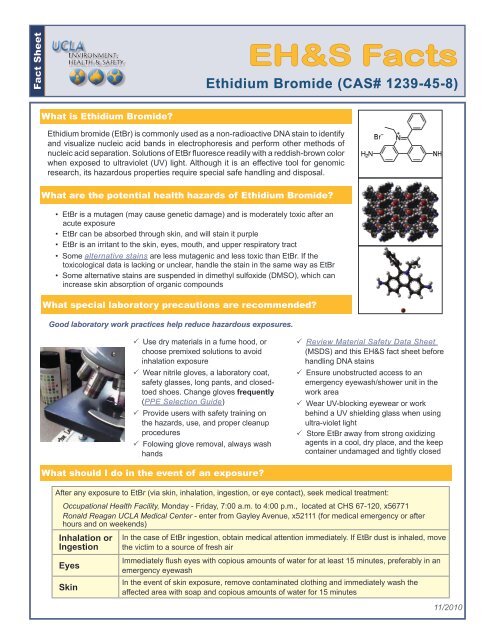Ethidium Bromide - UCLA - Environment, Health & Safety
Ethidium Bromide - UCLA - Environment, Health & Safety
Ethidium Bromide - UCLA - Environment, Health & Safety
You also want an ePaper? Increase the reach of your titles
YUMPU automatically turns print PDFs into web optimized ePapers that Google loves.
Fact Sheet<br />
What is <strong>Ethidium</strong> <strong>Bromide</strong>?<br />
EH&S Facts<br />
<strong>Ethidium</strong> <strong>Bromide</strong> (CAS# 1239-45-8)<br />
<strong>Ethidium</strong> bromide (EtBr) is commonly used as a non-radioactive DNA stain to identify<br />
and visualize nucleic acid bands in electrophoresis and perform other methods of<br />
nucleic acid separation. Solutions of EtBr fluoresce readily with a reddish-brown color<br />
when exposed to ultraviolet (UV) light. Although it is an effective tool for genomic<br />
research, its hazardous properties require special safe handling and disposal.<br />
What are the potential health hazards of <strong>Ethidium</strong> <strong>Bromide</strong>?<br />
• EtBr is a mutagen (may cause genetic damage) and is moderately toxic after an<br />
acute exposure<br />
• EtBr can be absorbed through skin, and will stain it purple<br />
• EtBr is an irritant to the skin, eyes, mouth, and upper respiratory tract<br />
• Some alternative stains are less mutagenic and less toxic than EtBr. If the<br />
toxicological data is lacking or unclear, handle the stain in the same way as EtBr<br />
• Some alternative stains are suspended in dimethyl sulfoxide (DMSO), which can<br />
increase skin absorption of organic compounds<br />
What special laboratory precautions are recommended?<br />
Good laboratory work practices help reduce hazardous exposures.<br />
3 Use dry materials in a fume hood, or<br />
choose premixed solutions to avoid<br />
inhalation exposure<br />
3 Wear nitrile gloves, a laboratory coat,<br />
safety glasses, long pants, and closedtoed<br />
shoes. Change gloves frequently<br />
(PPE Selection Guide)<br />
3 Provide users with safety training on<br />
the hazards, use, and proper cleanup<br />
procedures<br />
3 Folowing glove removal, always wash<br />
hands<br />
What should I do in the event of an exposure?<br />
3 Review Material <strong>Safety</strong> Data Sheet<br />
(MSDS) and this EH&S fact sheet before<br />
handling DNA stains<br />
3 Ensure unobstructed access to an<br />
emergency eyewash/shower unit in the<br />
work area<br />
3 Wear UV-blocking eyewear or work<br />
behind a UV shielding glass when using<br />
ultra-violet light<br />
3 Store EtBr away from strong oxidizing<br />
agents in a cool, dry place, and the keep<br />
container undamaged and tightly closed<br />
After any exposure to EtBr (via skin, inhalation, ingestion, or eye contact), seek medical treatment:<br />
Occupational <strong>Health</strong> Facility, Monday - Friday, 7:00 a.m. to 4:00 p.m., located at CHS 67-120, x56771<br />
Ronald Reagan <strong>UCLA</strong> Medical Center - enter from Gayley Avenue, x52111 (for medical emergency or after<br />
hours and on weekends)<br />
Inhalation or<br />
Ingestion<br />
Eyes<br />
Skin<br />
In the case of EtBr ingestion, obtain medical attention immediately. If EtBr dust is inhaled, move<br />
the victim to a source of fresh air<br />
Immediately flush eyes with copious amounts of water for at least 15 minutes, preferably in an<br />
emergency eyewash<br />
In the event of skin exposure, remove contaminated clothing and immediately wash the<br />
affected area with soap and copious amounts of water for 15 minutes<br />
11/2010
What should I do in the event of a spill?<br />
Small Spills of Dilute EtBr Working Solution (1L) OR Spills of Concentrated EtBr (100% EtBr)<br />
1. Notify others in the area to stay away. If possible, confine the spill to a small area using a spill kit or absorbent<br />
material. Keep others from entering contaminated area with caution tape, barriers, etc.<br />
2. Evacuate the immediate area and prevent entry<br />
3. Call the EH&S Hotline for assistance (x59797)<br />
How do I dispose of <strong>Ethidium</strong> <strong>Bromide</strong> and its alternatives?<br />
The table below outlines proper disposal of different staining products used in the preparation of electrophoresis gels.<br />
Using the California definition of a hazardous waste, the legal disposal options are summarized for each product.<br />
Product Name<br />
Percent<br />
Solution<br />
Hazardous<br />
Waste?<br />
Mutagen?<br />
<strong>Safety</strong><br />
compared<br />
to EtBr<br />
<strong>Ethidium</strong> <strong>Bromide</strong> 100% Yes Yes N/A<br />
<strong>Ethidium</strong> <strong>Bromide</strong><br />
















